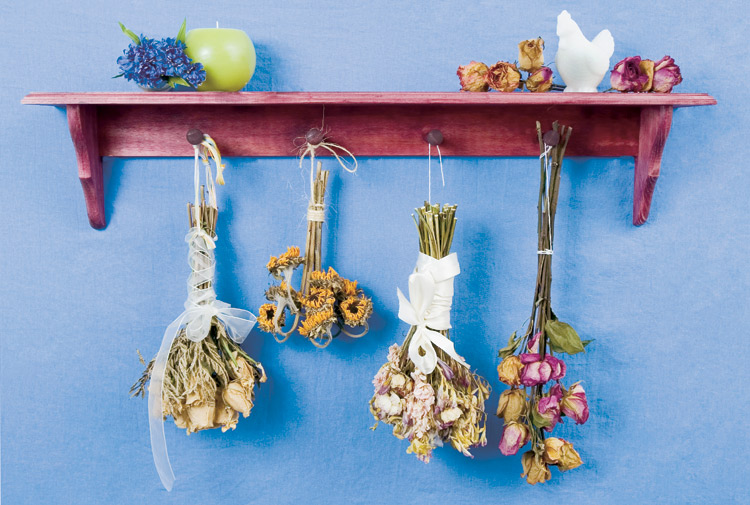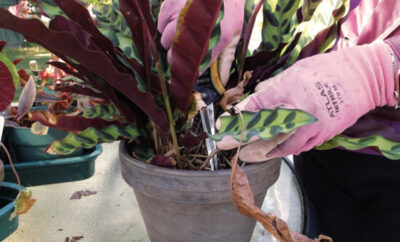How To Preserve Fresh Flowers
I love the fresh flowers from my garden so much that often I can’t let them go at the end of the growing season. Preserving my favorites lets me enjoy them year round, not just when the garden provides a steady supply.
1. Air-Dry Fresh Flowers
My favorite method of preserving flowers happens to be the simplest: air-drying.
To air-dry flowers, cut them just before they are fully open. Choose plants with long stems and remove the lower leaves. Put the flowers in small bunches, fastening them together with an elastic band or wire tie; then open each bunch into a fan shape. Hang the flowers head down from nails or a clothes hanger in a dry, dark place for one to three weeks until they are completely dry.
The colors will usually be muted, but they will last for about a year if kept out of direct sunlight.
Flowers that are easy to air-dry are baby’s breath, cattail, statice, strawflower, celosia, yarrow, blue salvia, artemisia, nigella, roses and goldenrod. Air-dried flowers are extremely stiff and good to use in arrangements.
2. Press and Frame Your Flowers
Pressing flowers is another way to preserve your favorite blooms for years to come. I’ve fashioned some beautiful picture arrangements with framed pressed flowers. Pressed-flower note cards and bookmarks make nice gifts, too.
You can purchase a commercial flower press or create your own with household items. First, you need unglazed paper, such as newsprint or an old telephone book. Place the flowers so that they do not overlap between several thicknesses of the paper. Next, weigh them down with a heavy object. (I use concrete blocks.) The drying time can last from two to four weeks.
Great flowers to press include pansies, violas, small daisies, ferns, forget-me-nots, lobelia, cosmos, Queen Anne’s lace, alyssum, small asters, autumn leaves, coreopsis and buttercup.
3. Use a Microwave to Dry and Preserve Flowers
For quick drying and for flowers that don’t air-dry well, try using your microwave oven (yes, you read that correctly). Select flowers just before they are mature because fully opened flowers often lose their petals after being microwaved.
Flowers dried with a microwave should be placed in a supporting medium so that they dry in their normal form. Drying agents such as a borax/sand mixture or kitty litter will do, but I have found that silica gel works best. Silica gel can be purchased from most craft and hobby stores.
To begin, work with freshly cut flowers. Cut off the stems close to the base of the flower. In the bottom of a microwave-safe container, place a 1-inch layer of silica gel and lay a blossom face down on the silica granules. Pour some additional silica granules over the flower until it is well covered. Then lay another flower face down and cover it, repeating the procedure until the container is full.
Use a microwave thermometer to determine the length of time needed to dry your flowers. Place the thermometer into the silica gel about a half-inch from the covered plant material. Make sure that you can read the thermometer from outside the oven.
Close the container with an appropriate lid and start microwaving. When the temperature of the silica gel reaches about 160 degrees, your flowers are done.
Remove the container of dried flowers from the microwave, slightly crack the lid, and allow it to sit about 24 hours before carefully uncovering the flowers.
If you can spare additional time, you can skip the microwave and simply use the drying medium – such as sand and borax (2:1 mixture) or cornmeal and borax (2:1 mixture). Bury your flowers as described in the microwave method, then seal and let them sit. Allow about one week to dry the flowers in silica gel or about 10 days if using cornmeal. About 16 days are needed if using sand. These drying materials can be used over and over if they are redried in a warm oven.














 My Indiana Home is produced for Indiana Farm Bureau members. Our mission is to connect you with the food you eat, the Indiana farmers who grow it and a rural lifestyle that is uniquely Hoosier.
My Indiana Home is produced for Indiana Farm Bureau members. Our mission is to connect you with the food you eat, the Indiana farmers who grow it and a rural lifestyle that is uniquely Hoosier.
Leave a Comment